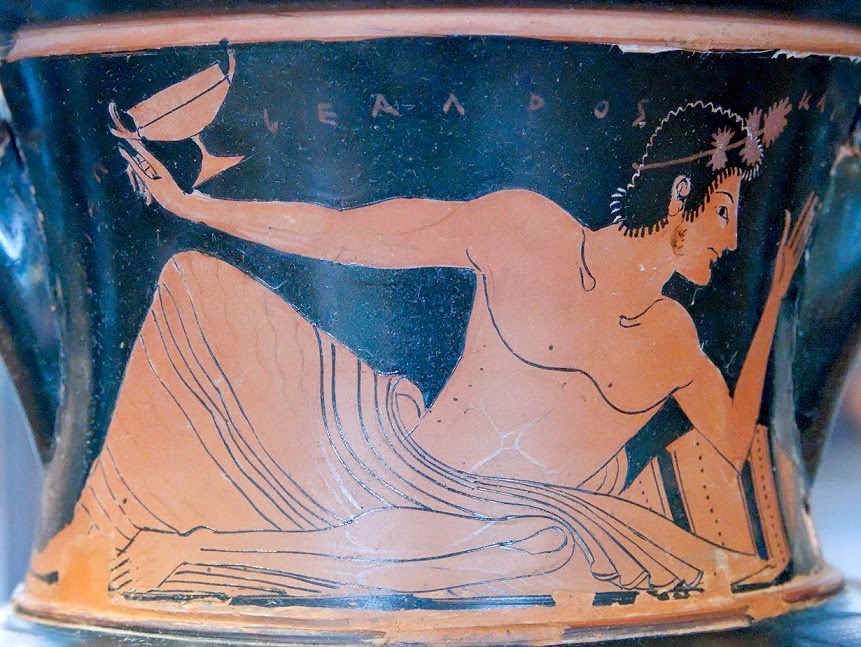Prima di essere tutti morti, gli antichi erano certamente molto vivi e gli piaceva divertirsi. Il gioco del bere (Kòttabos, Còttabo) ne è una prova convincente.
- Pare sia stato inventato da uno sconosciuto 'playboy siciliano (di origine greca) verso il 600 a.C. Egli scommise con i suoi amici che avrebbe colpito la lampada in cima al suo alto stelo con la feccia del vino rimasta nella sua coppa a due manici (kylix).
Si tratta di un modo piuttosto disastroso (per la pulizia della casa) di condurre una festa (simposio), ma certamente costituisce un'idea spettacolare, destinata ad avere successo tra persone amanti del divertimento e magari un po' annoiate...
- Fu subito modificata la lampada bronzea, in modo da diventare materiale più adatto per il gioco: in cima alla lampada fu posta una statuetta che reggesse un piatto in equilibrio molto precario. A metà dello stelo della lampada fu posto un disco molto largo, in modo che il piatto (plastinix) - cadendo - colpisse il disco (manes) producesse un suono molto simile ad un campanello. Il Kottabos ebbe tanto successo che dalla Sicilia rimbalzò fino alla Madre Patria e si diffuse in Atene e Sparta ed ebbe trecento anni circa di fortuna.
- Il gioco non è affatto facile: per quanto in equilibrio instabile, il piattino è pur sempre di bronzo e quindi relativamente molto pesante... I tiri migliori sono quelli che colpiscono dall'alto il plastinix, pertanto è preferibile prodursi in tiri molto arcuati.
- Certamente, il gioco era reso più interessante dalla coreografie di giovani schiave - vestite solo di ghirlande di fiori, per non sporcare inutilmente gli abiti - che si chinavano a raccogliere il plastinix, si sporgevano in alto per rimetterlo a posto e poi s'avvicinavano agli intervenuti per rifornire nuovamente le coppe dei partecipanti, semisdraiati sui loro lettini...
- Pare che vi fossero anche varianti per giocarlo: una consisteva nell'affondare alcuni piattini galleggianti in un recipiente più grande pieno d'acqua. Ad ogni lancio, il partecipante dedicava all'oggetto o persona dei propri desideri e non è difficile intuire come il gioco andasse a finire, visto che le donne 'per bene' (relegate nei ginecei anche a casa propria) non potevano partecipare al simposio, cui prendevano invece parte sempre e volentieri le etere...
Recreating
the ancient Greek drinking game
Kottabos
Years before beer pong was invented, the ancient Greeks played kottabos to pass the time at symposia (drinking parties) where privileged men reclined on cushion couches and played the game that is found illustrated on ancient artworks.
Women of fine society didn’t attend symposia but hetaires (courtesans) played the sloppy game where winners received all sorts of prizes, such as sweets and even sexual favours.
Banqueter playing the kottabos game;
kalos inscription in the name of Leagros.
Side A of the neck of an Attic red-figure neck-amphora, ca. 510 BC. From Vulci
[Credit: Marie-Lan Nguyen/WikiCommons]
Assistant Art History Professor Heather Sharpe of West Chester University in Pennsylvania tried to recreate the game with her students.
It wasn’t as easy as it appears “because we do have these illustrations of it, but they only show one part of the game – where individuals are about to flick some dregs at a target.” The students used a 3D-printed drinking cup, some diluted grape juice and willing students who soon got the hang of the game and the findings were presented at the annual meeting of the Archaeological Institute of America this month.
There are two ways of playing, according to texts and art works.
1) The goal is to knock down a disc carefully balanced a tall metal stand in the middle of the room.
2) In another version the goal was to sink small dishes floating in a larger bowl of water.
Players hit their target with the leftover wine-dregs at the bottom of their kylix (a two-handled ancient cup with shallow but wide body).
The tondo, circular curve inside the cup, revealed lewd pictures that were slowly revealed as the wine disappeared.
One kylix shows a man wiping his bottom, another shows a man penetrating a woman.
To achieve the best results in kottabos participants had to toss the wine-dregs overhand at their target as though they were pitching a baseball or throwing a frisbee.
Ancient Greek players would utter the name of the object of their affection before flinging the wine.
Luckily slaves were around to clean up the mess left behind as the game was likely to leave everyone splattered with wine and puddles all over the floor.
Source: Protothema [January 15, 2015]
